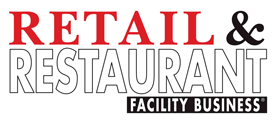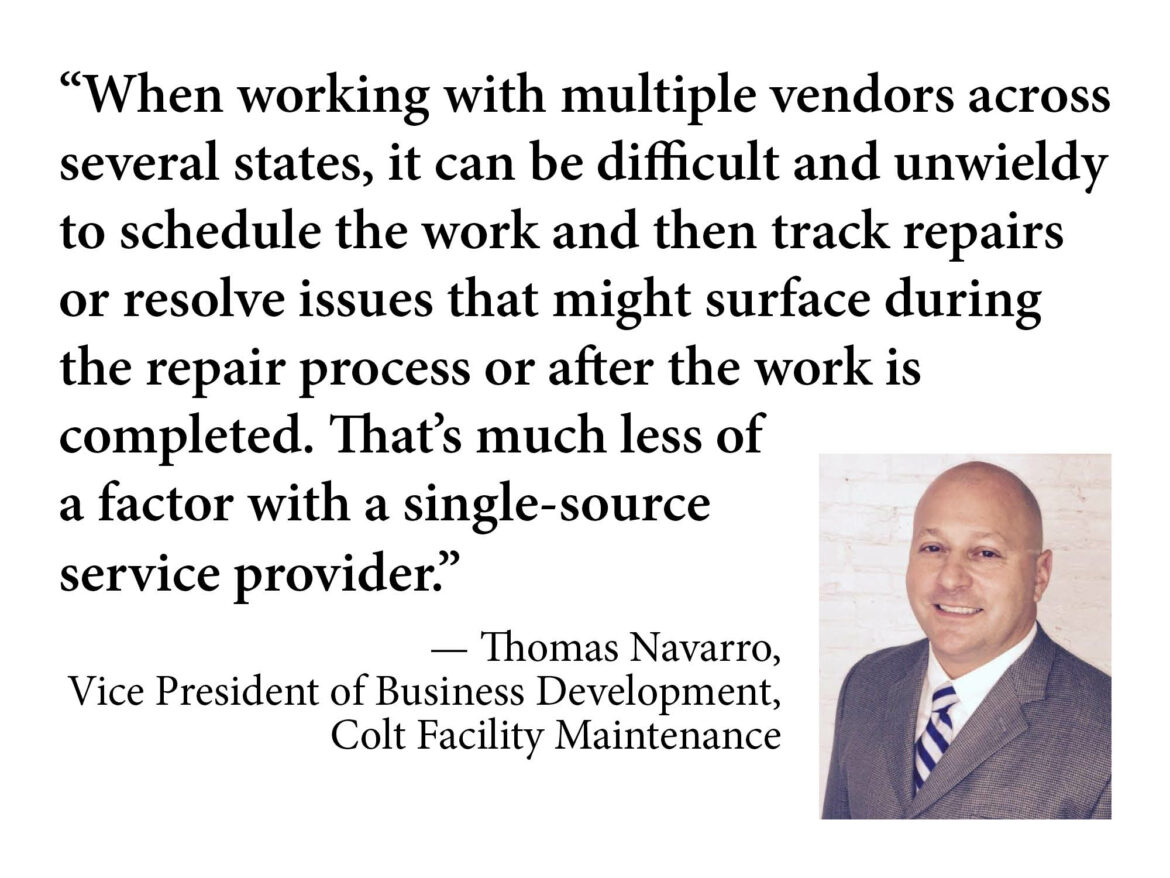One of the biggest challenges that retailers and restaurants face is finding a reliable, single-source facility repair and maintenance partner who has the scope, expertise and capacity to maintain and repair operationally vital systems in multiple locations.
When those store and restaurant operators have locations spread across states and regions with varying building, health, fire and safety codes, the difficulty is only compounded, says Thomas Navarro, vice president of business development for Colt Facility Maintenance. The Dallas-based repair and maintenance organization, also known as a self-performing provider, specializes in servicing retail and restaurant business footprints throughout the country and is particularly focused on the Sun Belt.
The efficiency and consistency associated with firms like Colt can limit business interruptions when issues arise in plumbing, electrical, refrigeration and heating, ventilation and cooling (HVAC) systems. Ultimately, that can help alleviate retailer and restaurant worries over the consequences of disruptions, namely lost revenue and unhappy customers who post poor reviews online.
“Regardless of what type of retail or restaurant business people run, they want repairs completed quickly,” Navarro says. “Effectively satisfying that expectation is critical to the performance of an operator’s physical assets. But more importantly, it is also critical to how consumers perceive the brand.”
Self-Performing Provider Advantage
Contracting with a single vendor means having only one point of contact for whatever issue might arise. Not only does the arrangement promote streamlined communication, faster response times and centralized scheduling, but it also provides retailers and restaurateurs with confidence that technicians will follow uniform work and safety procedures across all locations, Navarro adds.
Those efficiencies in and of themselves tend to fuel cost reductions. But a single facility maintenance and repair provider can deliver savings in other ways, Navarro says. The vendor is typically able to leverage economies of scale to achieve volume-based pricing for parts and equipment, which reduces per-call costs and eliminates additional third-party expense premiums related to subcontractor markups, he explains.
Additionally, self-performance providers tend to have lower travel costs due to optimized route and deployment strategies, Navarro says. Meanwhile, the practice of tracking service calls internally using methods such as checklists and audits ensures reliable outcomes. It also enhances vendor accountability, which can better facilitate dispute resolutions related to repairs. From the operator’s perspective, receiving invoices from a single vendor rather than numerous invoices from multiple service providers is also a time and money saver.
“By working with one vendor to take care of all of their needs, stores and restaurants can reap the benefits of a simplified repair and maintenance process as well as a consistent service experience,” Navarro declares. “When working with multiple vendors across several states, it can be difficult and unwieldy to schedule the work and then track repairs or resolve issues that might surface during the repair process or after the work is completed. That’s much less of a factor with a single-source service provider.”
Customer-Centered
Given the fact that self-performing maintenance providers service a diverse range of operations, they possess a deep well of knowledge concerning what types of issues are common among various uses. Convenience stores tend to generate high traffic throughout the day, for example, and consequently experience more problems with plumbing compared to more traditional retailers, Navarro says.
Just as notable, vendors like Colt are also able to leverage that experience and knowledge when tailoring programs to meet a client’s specific goals, needs and expectations, he adds. Often such initiatives include preventative maintenance plans, such as quarterly HVAC inspections and tune-ups. Among other tasks, technicians gauge efficiency and identify immediate problems or progressing wear-and-tear conditions that will require action in the future, he points out.
Preventative maintenance programs can not only increase the longevity of systems, but they also can help operators determine how to best allocate resources when confronted with replacement-versus-repair decisions. “Unexpected breakdowns frequently occur in equipment that is neglected,” Navarro reports. “Preventative maintenance programs really prove their value by dramatically reducing the frequency of emergency repairs and their associated costs.”
Handling Extremes
Similarly, self-performing providers can draw on their experience with weather events and natural disasters in different regions to more precisely inform the individual customer programs, Navarro adds. In some cases, that may mean offering vertically integrated disaster preparedness and response plans, from providing 24/7 storm monitoring to delivering reconstruction crews immediately after an event like a hurricane.
“Businesses want to return to operations as soon as practically possible following severe weather or a natural disaster,” Navarro says. “While it’s important to the health of the overall organization, it can also be critical to communities during recovery. Pharmacies and convenience stores are typically places where people can find essential resources.”
— By Joe Gose. Colt is a content partner of Retail & Restaurant Facility Business. For more articles from and news about Colt, click here.

